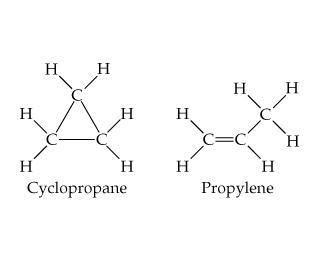
Answer
458.4k+ views
Hint: A molecule experiences strain when its chemical structure undergoes some stress which raises its internal energy in comparison to strain free reference compounds. When this strain is produced due to deviation in bond angles of a molecule, it is termed as angle strain.
Complete step by step answer:
Basically angle strain is the increase in potential energy of a molecule due to deviation of bond angles from ideal values. It is also termed as ring strain because it is mostly found in cyclic structures and due to rigidity, compounds can have only one conformation as we can see in the structure of cyclopropane.
Structure of cyclopropane:

As we all know that strain is calculated by the deviation in bond angle.
In our molecule Cyclopropane, the carbon has $s{p^3}$ hybridization which tells us that it should have an angle of $109^\circ 28'$ but due to its rigid structure, it actually can’t maintain this angle so as a result there is the generation of angle strain.
This angle strain is calculated in terms of bond angle which is as follows:
Deviation,$d = \dfrac{{109^\circ 28' - \alpha }}{2}$ , where $\alpha $ is the bond angle in Cyclopropane.
$ \Rightarrow \alpha = 60^\circ $
Now put the value of $\alpha $ in deviation formula.
Deviation ,$d = \dfrac{{109^\circ 28' - 60^\circ }}{2} = + 24^\circ 44'$
$ \Rightarrow $ Angle strain in Cyclopropane is $24^\circ 44'$ .
Hence option (A) is correct.
Note:
When we see any deviation in a molecule from its standard structure we can predict that it is a strained molecule. Scientifically it is predicted by the energy of molecules which is enhanced because of unfavourable bond lengths, bond angles or dihedral angles.
Complete step by step answer:
Basically angle strain is the increase in potential energy of a molecule due to deviation of bond angles from ideal values. It is also termed as ring strain because it is mostly found in cyclic structures and due to rigidity, compounds can have only one conformation as we can see in the structure of cyclopropane.
Structure of cyclopropane:

As we all know that strain is calculated by the deviation in bond angle.
In our molecule Cyclopropane, the carbon has $s{p^3}$ hybridization which tells us that it should have an angle of $109^\circ 28'$ but due to its rigid structure, it actually can’t maintain this angle so as a result there is the generation of angle strain.
This angle strain is calculated in terms of bond angle which is as follows:
Deviation,$d = \dfrac{{109^\circ 28' - \alpha }}{2}$ , where $\alpha $ is the bond angle in Cyclopropane.
$ \Rightarrow \alpha = 60^\circ $
Now put the value of $\alpha $ in deviation formula.
Deviation ,$d = \dfrac{{109^\circ 28' - 60^\circ }}{2} = + 24^\circ 44'$
$ \Rightarrow $ Angle strain in Cyclopropane is $24^\circ 44'$ .
Hence option (A) is correct.
Note:
When we see any deviation in a molecule from its standard structure we can predict that it is a strained molecule. Scientifically it is predicted by the energy of molecules which is enhanced because of unfavourable bond lengths, bond angles or dihedral angles.
Recently Updated Pages
Who among the following was the religious guru of class 7 social science CBSE

what is the correct chronological order of the following class 10 social science CBSE

Which of the following was not the actual cause for class 10 social science CBSE

Which of the following statements is not correct A class 10 social science CBSE

Which of the following leaders was not present in the class 10 social science CBSE

Garampani Sanctuary is located at A Diphu Assam B Gangtok class 10 social science CBSE

Trending doubts
A rainbow has circular shape because A The earth is class 11 physics CBSE

Which are the Top 10 Largest Countries of the World?

Fill the blanks with the suitable prepositions 1 The class 9 english CBSE

What was the Metternich system and how did it provide class 11 social science CBSE

How do you graph the function fx 4x class 9 maths CBSE

Give 10 examples for herbs , shrubs , climbers , creepers

The Equation xxx + 2 is Satisfied when x is Equal to Class 10 Maths

What is BLO What is the full form of BLO class 8 social science CBSE

Change the following sentences into negative and interrogative class 10 english CBSE




